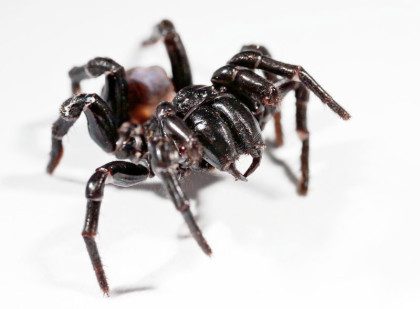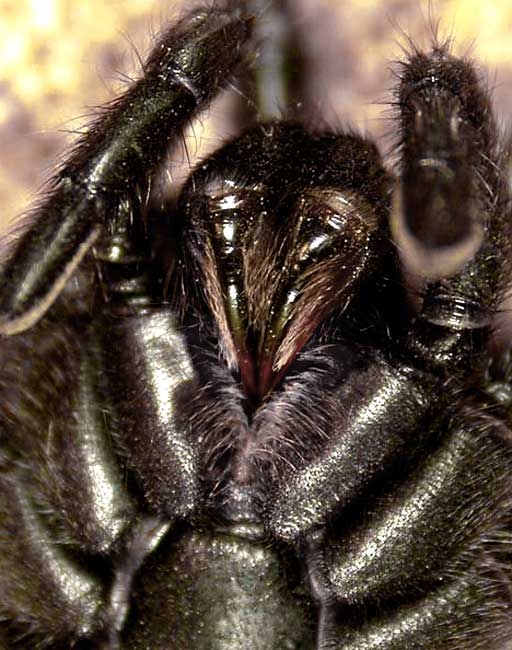The Sydney funnel web spider (Atrax robustus) is widely regarded as the most dangerous spider in Australia, if not the World. It is actually responsible for many less bites than the also notorious redback spider. However, whilst both are potentially lethal the funnel web has a stronger venom which it is much more capable of delivering. The funnel web also has a well earned reputation of being one of the most aggressive spiders you’ll com across.
- Funnel-web spiders belong to the family Hexathelidae. There are around 30 species of funnel web spiders many of which can give a very painful bite.
- Funnel web spiders are mygalomorph spiders. Like the tarantulas, the fangs point down as opposed to crossing, pincer style.
What does a Sydney funnel web spider look like?
-

Photo: Sputniktilt / License The head and thorax are hairless and a glossy blue-black. The abdomen can be more brown in colour and is covered in velvety hair.
- There are a pair of large, finger-like spinnerets at rear of the abdomen.
- The name Atrax robustus refers to the spiders stocky build. I.e. robust means strong/sturdy. This is true of the shiny solid legs, particularly of the female. The male’s legs tend to be a little thinner.
- Like with most spiders the female is considerably bigger than the male. The spider’s body length measures 25mm (1 inch) and 35mm (1.4 inches) respectively.
- Another identifying feature of the male is the spur halfway along the second set of legs.
- The female funnel web spiders can live up to 8 years or more. Males live significantly shorter.
- A number of other Australian spiders are commonly mistaken for Sydney funnel-webs. These include mouse spiders, trapdoor spiders and sometimes black house spiders.
Where do you find Sydney funnel web spiders?
- It might seem obvious, but yes, Sydney funnel webs are indeed found in and around Sydney, Australia. That said they live within a 100 miles (160km) range of Sydney.
- These spiders are found all along the New South Wales coast and as far inland as Lithgow (about 100 miles inland of Sydney)

- These spiders are more common inland than on the coast as they prefer less sandy, moister soil to burrow in.
- As the name suggests the spider lives in a funnel shaped web. This is usually a burrow or crevice lined with silk which opens up in a T-shaped or Y-shaped entrance. When a prey animal touches the outer part of the web the spider darts out and sinks its fangs in.
- The burrow and web can be anywhere from 20 to 60 cm (up to 2ft) deep.
- Burrows are made in humid, sheltered places. For example under houses, crevices between rocks or in holes in trees.
Sydney funnel web bites and venom
-

Photo: Steven Clark / License This is the most venomous spider in Australia, and second in the world. The venom twice as strong as cyanide.
- Unlike many spiders the venom of the male is far more potent than the females. Up to 6 times more toxic.
- Juvenile spider venom is also less toxic.
- The toxic ingredient to the venom is the neurotoxin atraxotoxin a substance that attacks the nervous system effecting any of the body’s organs. It works by preventing nerve impulses being switched off.
- Rats, rabbits and cats and some other animals are unaffected by the bite of a female spider. Male venom only slight effect on cats and dogs. Primates (humans and monkeys) appear to be most susceptible, along with guinea pigs and mice.
- The spider’s fangs are bigger than those of a brown snake (which are admittedly small at about 1 cm).
- The fangs (or chelicerae) are also very sharp and strong. They are allegedly able to pierce a fingernail and shoe leather.
- The bite:
Initially very painful due to the large size of the fangs and the acidic venom. Bites leave clear fang marks separated by several millimetres. - When the funnel web bites it often clings on and bites repeatedly until it is brushed off.
- Only 1 in 6 bites are serious as most people bitten are not injected with sufficient venom to cause serious problems.
- Secondary symptoms occur between 10 and 30 minutes after the bite. These include:
breathing and circulatory problems, muscle spasms, tears, drooling, vomiting, diarrhoea and possibly death within 2 hours. In one case a small child was dead within 15 minutes. - Evidence suggests that the effects of the venom wear off after a few hours
- There were 15 recorded deaths caused by the funnel web between 1927 and 1981. Where reported the spider was always male.
- Antivenom was developed in 1981 since which time there have been no fatalities.
One dose of antivenom requires around 70 milkings from a spider.
Sydney funnel web spider behaviour
- Like all spiders the funnel web is carnivorous. Typical prey includes cockroaches, beetles, snails, millipedes and occasionally frogs or other small vertebrates such as lizards.
- The male is generally solitary. Spends his time wandering and looking for a suitable mate.
- Females tend to stay in the same place and can occur in “colonies” of over 100 spiders (Yikes!)
- Like many spiders the funnel web is active at night. I.e. nocturnal. This is partly because the daytime temperatures would dehydrate them.
- The spiders are particularly active after heavy rainfall. Partly because their burrows tend to flood.
Amazing Sydney funnel web facts and myths
- The silk of the Sydney funnel web spider is used to make crosshairs in optical equipment.
- These spiders can survive immersion in water for over 24 hours. They manage this by trapping air bubbles in the hairs of their abdomen.
This is particularly useful as the funnel-webs have a habit of wandering into suburban gardens and falling in the swimming pool. - Sydney funnel webs do not live in houses. They may enter houses though, particularly in the summer after a downpour.
- These spiders do not chase people and certainly do not jump. It is an urban myth that the funnel web will jump at you when attacking.
Sydney funnel-web spider bite treatment
- Keep calm. Don’t panic!
- Move only if absolutely necessary.
- If it is a limb that is bitten apply a pressure bandage much as you would to a snake bite. The bandage should be around the area and the limb towards the heart.
- Immobilise the limb with a splint.
- If possible, carefully catch the spider, even if squished. This is important for identification and further treatment.
- A bite from the sydney funnel-web should be regarded as a medical emergency. Seek medical aid as quickly as possible.
How to avoid being bitten
Obviously not being bitten is preferable to any form of treatment. If you are in an area known for these spiders the following precautions are advisable:
- Know what the spider and its burrows look like.
- Wear thick gloves when gardening.
- Wear fully enclosed shoes.
- If camping close tent flaps and shake out any shoes, clothing or equipment left out overnight.






I looked up “will a funnel spider jump at you?” on Google and find the seemingly universal advice that the answer is no.
However, this advice s false.
I lived in a house in Queanbeyan near Canberra in NSW, more than 40 years ago. There was a funnel shaped web up high on the wall near the front door of the housel.
I have every reason to think it was the web of a funnel web spider.
One day I was watching warily as I walked past, and the spider jumped at me. “Jumped” does not imply that the spider was adept at high jumping or long jumping. Preumably all it had to do was step into space and free fall.
The advice also given is that trapdoor spiders cannot climb walls. I don’t think this advice was correct because its nest was at a height of 2 metres on the wall.